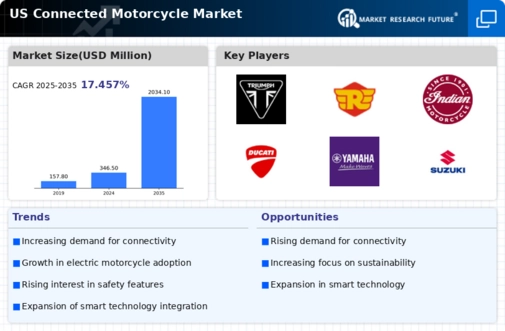The US Connected Motorcycle Market is experiencing a significant transformation driven by technological advancements and evolving consumer preferences. As motorcycle manufacturers increasingly integrate connectivity features, such as GPS navigation, real-time diagnostics, and smartphone integration, they are competing to capture the attention of tech-savvy riders. Key players are focusing on enhancing the rider experience and providing improved safety features through connectivity. This competitive landscape is characterized by innovation, with companies investing in research and development to create motorcycles that not only provide mobility but also offer integrated solutions tailored to the demands of modern riders.
Market dynamics are influenced by the growing popularity of smart technologies, and the competitive insights highlight how these companies are adapting their strategies to leverage connectivity in order to gain market share and enhance brand loyalty.In the US Connected Motorcycle Market, Triumph has established a robust presence characterized by its commitment to quality and innovation. The brand is known for its advanced engineering and dedication to delivering high-performance motorcycles that appeal to enthusiasts. Triumph’s strong community engagement through riding events and brand ambassador initiatives has fostered a loyal following, reinforcing its market position.
The incorporation of advanced connectivity features within their models has also positioned Triumph favorably in a sector leaning towards integrated mobility solutions. The brand has capitalized on its heritage and reputation for performance while embracing modern technology, thereby enhancing its appeal to both traditional motorcycle enthusiasts and new riders seeking connected experiences.Royal Enfield is carving out its niche in the US Connected Motorcycle Market by focusing on accessible riding experiences while introducing connectivity features.
The company is known for its classic design and affordability, making it appealing to a wide demographic. In recent years, Royal Enfield has incorporated smart technology into their models, which adds value through enhanced rider safety and convenience. The brand has made significant strides in increasing its market presence through strategic partnerships and collaborations that aim to diversify its product offerings.
Notably, Royal Enfield's key products in the connected motorcycle segment include models equipped with GPS navigation and mobile app integration, which enhances the overall user experience. The brand has effectively utilized mergers with local entities to expand its footprint in the US, resulting in a more formidable presence in the market. Strengthened by their heritage, affordability, and strategic initiatives, Royal Enfield continues to be a competitive player in the evolving landscape of connected motorcycles in the US.






















